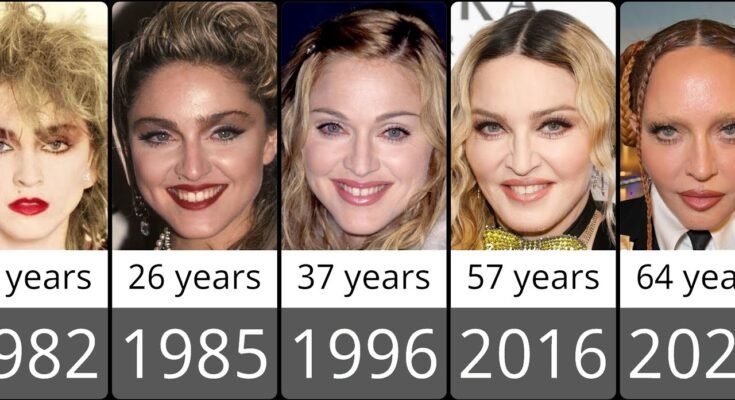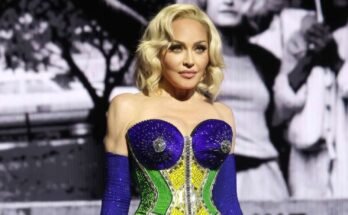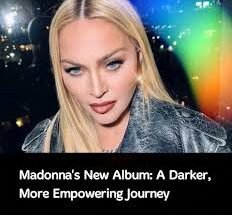Few figures in pop culture have had the transformative power and staying power of Madonna. From her emergence in 1982 to her career in 2023, Madonna Louise Ciccone has not only shaped the music industry but has also been a cultural barometer, consistently pushing boundaries in fashion, gender politics, religion, and fame itself. Her journey is one of fearless reinvention, provocation, and resilience—a blueprint for any artist aspiring to longevity in the fickle world of entertainment.
1982–1984: The Birth of a Pop Icon
Madonna burst onto the music scene in 1982 with the release of her debut single “Everybody.” Although initially credited anonymously, the single became a hit in New York dance clubs and led to her first album, Madonna (1983). With tracks like “Holiday” and “Borderline,” she introduced herself as a new kind of pop star—fierce, fun, and unapologetically herself.
Her fashion during this era—lace tops, fingerless gloves, crucifixes, and layered skirts—became instantly iconic. By the time she performed “Like a Virgin” at the 1984 MTV Video Music Awards, writhing on stage in a wedding dress, she had cemented herself as a force of nature.
1985–1989: Superstardom and Controversy
Madonna’s rise in the second half of the ’80s was meteoric. Her albums Like a Virgin (1984), True Blue (1986), and Like a Prayer (1989) produced chart-topping hits and sparked social debates. Songs like “Papa Don’t Preach” and “Like a Prayer” brought taboo topics like teen pregnancy and religious symbolism into pop discourse.
She starred in movies such as Desperately Seeking Susan (1985) and married actor Sean Penn, creating a media frenzy. Madonna wasn’t just making music—she was creating headlines. Her command of controversy wasn’t accidental; it was strategic. She understood that control over image and narrative was power.
1990–1999: Erotica, Feminism, and Artistic Boldness
The 1990s saw Madonna challenging societal norms more aggressively. Her 1992 album Erotica and the accompanying coffee-table book Sex shocked conservative America with its overt sexuality. Critics dismissed her, but fans saw her as a feminist trailblazer, reclaiming female sexuality in a male-dominated industry.
She rebounded with more introspective and spiritual projects like Bedtime Stories (1994) and Ray of Light (1998), the latter influenced by her studies in Kabbalah and motherhood. Ray of Light was a critical and commercial triumph, showcasing a mature Madonna embracing electronic sounds and profound lyrics.
2000–2009: Reinvention, Touring Queen, and Cultural Relevance
Madonna entered the 21st century with the album Music (2000), proving her relevance in the digital age. Her Drowned World Tour (2001) and Confessions Tour (2006) were global spectacles, mixing high fashion with elaborate stagecraft. Confessions on a Dance Floor (2005) was a dance-pop masterpiece that thrilled critics and fans alike.
Her ability to stay current with trends while retaining her unique voice kept her career afloat as other ’80s stars faded. She adopted new sounds, collaborated with younger artists, and used music videos as performance art. Her political voice grew louder as well, speaking out on war, gender, and inequality.
2010–2019: Legacy Mode and Challenges
In her 50s and 60s, Madonna remained prolific. Albums like MDNA (2012) and Rebel Heart (2015) received mixed reviews but confirmed her refusal to slow down. Her Madame X Tour (2019) showcased a character-driven theatrical show with a strong political undertone.
Her persona shifted from trendsetter to legacy artist, often criticized for chasing youth, yet her fans saw her as an icon unafraid of aging in public. She also faced the evolving dynamics of fame in the era of social media, where younger stars dominated platforms she never needed in her prime.
Still, Madonna continued to push the envelope—whether through fashion, statements on Instagram, or speaking out on ageism and sexism. She adopted six children from Malawi and became increasingly involved in philanthropy through her Raising Malawi foundation.
2020–2023: Enduring Relevance in a Changing World
The early 2020s presented new challenges. The COVID-19 pandemic disrupted her Madame X Tour. Meanwhile, her social media presence became erratic, leading to divided opinions. Yet through it all, Madonna remained uncompromising.
In 2022, she released Finally Enough Love: 50 Number Ones, celebrating her unmatched record of dance hits—a reminder of her unparalleled influence on the club scene and pop charts.
The biggest highlight of 2023 was her “Celebration Tour”, which was both a retrospective and a spectacle. Spanning decades of hits, the tour reaffirmed Madonna’s position as one of the greatest live performers of all time. Despite a serious health scare in mid-2023—a bacterial infection that required hospitalization—she bounced back, finishing the tour triumphantly.
Influence, Legacy, and Cultural Impact
From Lady Gaga to Beyoncé, from Dua Lipa to Taylor Swift, modern pop stars owe a debt to Madonna’s blueprint: control over image, fierce independence, and genre-hopping experimentation.
Her impact also goes beyond music. She challenged the Catholic Church, championed LGBTQ+ rights long before it was fashionable, and insisted that women could be complex, sexual, political, and powerful—all at once.
Madonna never played by the rules. And in not doing so, she rewrote them.
Conclusion: Madonna—Not Just a Pop Star, a Cultural Force
From 1982 to 2023, Madonna evolved from a scrappy club singer to an immortal icon. Her story isn’t just about hits or headlines—it’s about survival in an industry that often chews women up and spits them out. She not only survived; she thrived, defied, and transformed.
As she once sang, “I’m gonna carry on.” And carry on she has—across four decades of style, scandal, and stardom.
Madonna doesn’t just belong to the past—she continues to challenge the present and shape the future.
If you’d like this article formatted for a blog, magazine, or as part of a timeline, I can adapt it accordingly!



